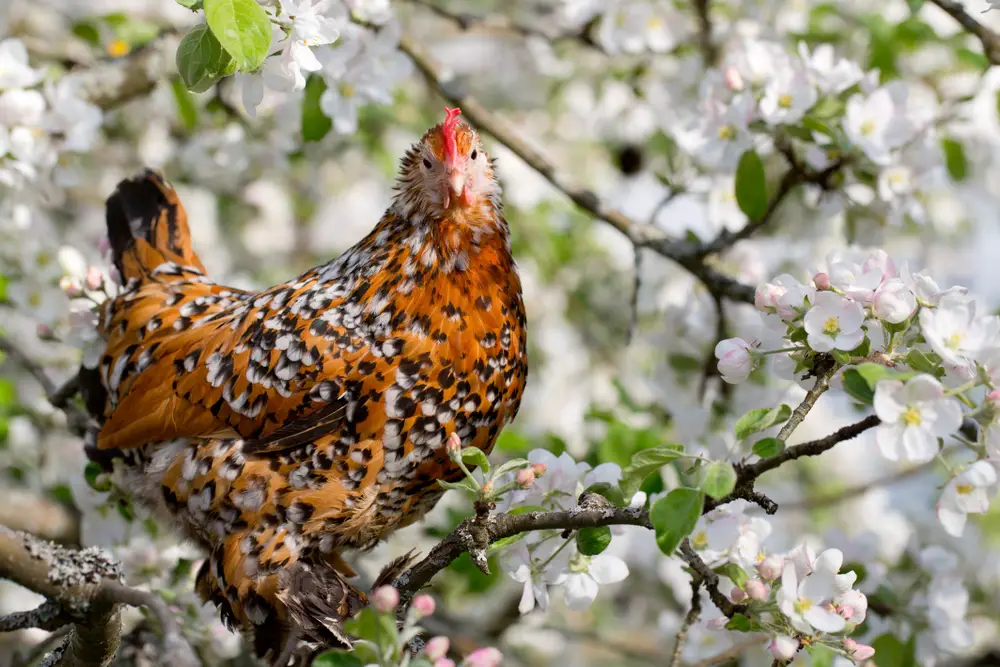Beautiful, calm, and sweet-mannered, Mille Fleur chickens can be a great addition to your backyard flock. Besides their big personalities, these chickens make ideal pets and show birds but terrible egg layers given they only lay 2 to 3 eggs per week.
Don’t let their size fool you though! Mille Fleur chickens have huge personalities and are good fliers, and when adding these bantam chickens to your suburban or urban flock, will bring you a ton of visitors.
From eggs to temperament, this guide will explore the Mille Fleur Chicken in great detail to help you determine if this bird is suited to your family.
Table of Contents
History
A variety of the renowned Belgian d’Uccle bantams, Mille Fleur Chicken are true bantams. Mille Fleur is French for ” thousand flowers.”
These bearded and feather-footed birds originated from Belgium and were developed in the early 20th century by a Dutch national named Michael van Gelder.
The very first Mille Fleur d’Uccle variation was recognized by the American Poultry Association’s Standard of Perfection in 1914.
Mille Fleur Chicken Breed Overview
| Recognized Breed Name | Mille Fleur Chicken |
| Lifespan | 7 to 8 years |
| Coloring and Pattern | White, black, and Gold Spotted |
| Comb Type | Rose Comb |
| Known For | Remarkable show birds and beautiful pets Being able to fly over fences and into trees |
| Feather Type | Frizzle |
| Heritage Breed | Yes |
| Tolerant to Heat? | Mild heat is OK |
| Tolerant to Cold? | Milk cold is OK |
| Meat Production Breed? | No |
| Egg Production Breed? | No |
| Lays in Winter? | No |
| Egg Size | Small |
| Egg Color | Dream |
| Egg Production | 100 to 150 per year |
| Starts Laying | 20 weeks |

Physical Characteristics
When it comes to pet chickens, the different breeds called Belgian d’Uccles are excellent choices thanks to their manageable size and friendly disposition.
They also have endearing looks, with full beards, feathered legs, and numerous cape or hackle feathers.
The American Poultry Association has recognized 7 colors including Mille Fleur, Mottled, Lavender, Porcelain, Black, White, and Golden Neck.
Many more colors are recognized in Europe, including silver quail, quail, blue, black-mottled, lavender, and cuckoo. In Belgium alone, there are more than 2O recognized color variations.
Egg Production
Although Mille Fleur d’uccle Bantam chickens are not known for excellent egg-laying abilities, they still lay around 100 to 150 small white eggs per year.
They start laying late in spring but continue to lay throughout winter. They are known to go broody, but not all Belgian d’Uccle chickens will go broody. The hens that do will make great moms to their baby chicks.
Temperament
Mille Fleur Chickens are a docile, friendly variation of the Belgian d’Uccles breed. Generally, the hens and roosters are both calm. The hens will produce an egg song while the roosters will crow loudly. Most Belgian d’Uccles do not make a lot of noise.
Bantam breeds like the Mille Fleur are vulnerable to bullying by bigger chickens. Consider keeping your bantam chickens separately so they won’t compete with larger breeds to reach a top position in the pecking order. Chickens that are lower in the pecking order might not be able to get their fair share of food, water, roosts, or nest boxes.

Mille Fleur chickens are not aggressive and most can be taught to get along well with people, including children.
Feeding, Coop and Health
Baby chicks require a high-quality chick starter feed containing 20 percent protein to give them a good start in their life. After 16 weeks, you can transition them to a 16 percent layer feed.
Mille Fleur chickens tend to bill out feed. This means they remove the feed from the feeder and eat it from the floor. To prevent this, you should use a chicken feeder with a lip.
During the molting season, give them 20 percent protein chicken feed. You should also feed them high-protein treats like mealworms, sardines, and tuna.
This true bantam chicken breed is very energetic and do not like being confined for long hours. They enjoy foraging and running around, and if kept in confinement, the chicken coop must be spacious enough to hold 1 bird per every 40 square feet.
Generally, Millie Fleur chickens are healthy but are prone to leg mites due to their leg feathers. Other conditions that can affect these bantam chickens are Marek’s disease and coccidiosis.
Benefits To Raising a Mille Fleur Chicken
Here is what you can expect once owning this breed:
- Small Stature: Mille Fleur chickens are ideal for raising in the city or suburbs. They can comfortably stay in small coops.
- Save Money on Feed: These little chickens do not consume a lot of feed when compared to other breeds
- Ideal Pets: Mille Fleur chickens are calm, friendly and enjoy hanging out with owners who are working in the garden
- Good for kids or beginners: Their small size makes them easy to raise for both young children and novice chicken keepers.
FAQs
What does the term “Mille Fleur ” mean?
This breed hails from Belgium, but the term “Mille Fleur d’Uccle” is of French origin. Mille Fleur means “thousand flowers”. Uccle is a suburb of Brussels where the breed originated from.
How Big Do Mille Fleur chickens get?
These chickens are very small. The hens reach 2.3 pounds while roosters reach around 1.6 pounds. With their small bodies and few eggs, Mille Fleur chickens are mainly kept as pets or for exhibition.

